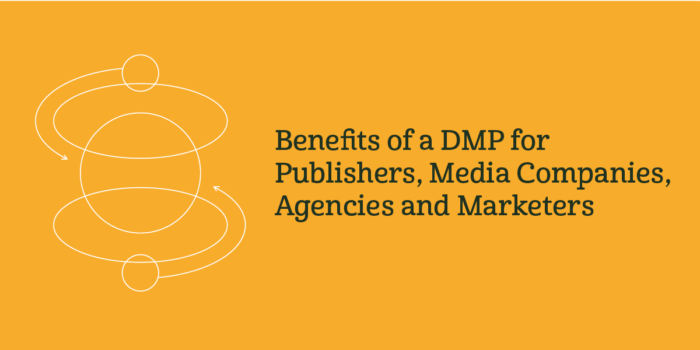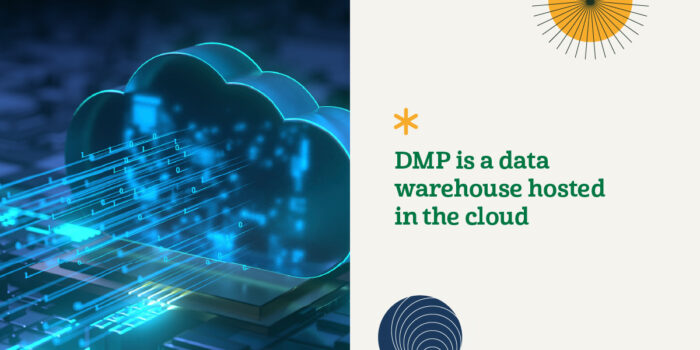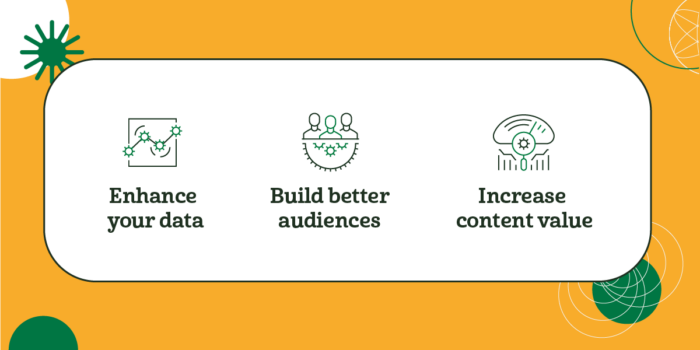
As the amount of data that consumers generate grows, so does the potential to use it to advance your company goals. Virtually every online action customers take produces data. You can use the collected data to inform marketing strategies, increase engagement, and improve your bottom line. To access the benefits this data offers, you need to be able to collect, organize, activate, and analyze it to extract insights. That’s where data management platforms, or DMPs, come in.
Marketers, publishers, media companies and agencies need to sort, organize and activate the endless streams of data they collect. One of the most significant benefits of a data management platform is that these systems provide organizations and teams with the necessary resources to make sense of the data they have. But that’s only the beginning — DMPs are more beneficial than you may know. This guide will explore the many advantages of using an organized data management platform and the value it can bring to your business.
What Is a DMP?

What is the meaning of the term DMP? In its most simplistic form, a DMP is a data warehouse hosted in the cloud. As soon as a business starts working with a DMP, it begins collecting, sorting and storing any information to which it’s connected. Then, it takes that data and translates it into a more useful form, showing trends, insights and statistics. Ultimately, this allows marketers, publishers and agencies to turn these insights into actions, and use them to inform their marketing campaigns.
In the marketing world, DMPs are most commonly associated with audience targeting. For example, the collected data might provide a marketing team with information that helps them target a specific user base or demographic through online ads. But in fact, DMPs have many applications beyond sending targeted messaging to specific audiences.
There’s a good reason for the popularity of these solutions. They have many tangible benefits and go above and beyond the standard analytics tools that most marketers know.
How Does a DMP Work?
A DMP is a unifying platform for collecting and combining data about your audience from various online, offline, mobile and connected TV sources. Aggregating first-, second- and third-party user data from these channels within a DMP enables you to identify your audiences and improve your messaging. With this information, you can connect more meaningfully and run more successful ad campaigns.
While first-party data is beneficial to your marketing practices, using it exclusively means narrowing your reach. Second-party data involves negotiation between companies, who share information to create a mutual gain. Collecting and analyzing these two varieties of data are both advantageous, but neither scales as much as third-party data. Third-party data consists of details gathered during purchases and collectively provides information about consumer demographics and behavior.
A DMP performing at its full potential helps you attain a panoramic view of your consumers that you wouldn’t be able to create otherwise. Perhaps you would be able to organize and analyze the first-party data from your own physical and digital properties without a comprehensive platform. However, it would be far more challenging to use datasets from third-party data providers and to send the information gained to the right places for activation.

Your DMP can ensure that you pull the right information while performing these tasks. Through translating, classifying, indexing and storing data, you’ll be able to leverage the platform’s intelligence to benefit both your audience and your company’s bottom line.
Benefits of a Data Management Platform
As businesses evolve to meet the demands of consumers, data becomes more and more essential. The modern market is exceptionally competitive, and collecting and analyzing consumer information can put your business ahead of the rest.
Your response has to be quick and tailored to your audience if you want to take advantage of the information you receive. A DMP can help publishers, media companies and marketers alike manage the information they collect and turn it into tangible benefits for their businesses.
The Benefits of a DMP for Publishers & Media Companies
Publishers and media companies who use a data management platform have several advantages over those who don’t. They’re able to collect and analyze information faster and translate their findings into content for customers and advertising opportunities for their partners. With a DMP, you’ll be able to:

1. Enhance Your Data
DMPs collect all that data and conveniently store it in one place, so you have one cohesive view of your customers across the web, mobile apps, email, CTV/OTT, CRM and an assortment of smart devices. DMPs process, organize and prepare your information. By doing so, they offer a much clearer picture and a better understanding of your audience, strategies and efforts. The result is the ability to make more informed decisions across all areas of your company.
With a DMP, you gain access to a central system that collects and organizes all of your company’s data. It enables you to see the larger picture and have a clear understanding of what’s working for you and what’s not. This knowledge can help you cut down on the time your company needs to spend combing through raw data.
2. Build Better Audiences
With the help of a DMP, publishers and media companies can build audiences that perform. Beyond your target demographics, the data and analytics can help you identify the behaviors and preferences of individuals that visit your site or view your content. With new information, you can segment your audiences differently.
In some cases, you’ll be able to find groups within your visitors that you hadn’t known about previously. The information provided by a DMP will help you identify and reach these groups.
The way the DMP functions is by rapidly processing data and sorting it into many different segments. It can go through more information in a shorter time than a human could in years of diligent work. With the speed of a data management platform, you’ll be able to identify new audience segments as they shift and change. Identification is only the first of several steps, and with the right focus, you can amplify new subscriptions and increase revenue.
The patterns and additional viewpoints you discover will allow you to target people more accurately, creating messages that inspire action.
3. Increase Content Value
Paying attention to first-party data is essential to creating more valuable content. Using a DMP means publishers and media companies can quickly collect and analyze data from all available platforms. With these sets of data, they can accurately target audience segments by creating strategic content. Tailoring content to audience segments with the help of a DMP allows publishers and media companies to gain impressions from their intended market.
It also creates new options for advertisers. The more opportunities they have available to work with, the more credibility they can build for you and your brands. With a DMP, you can choose precisely which advertisers you want to share data with to create opportunities. For those with valuable first-party data, you can also use a DMP to sell that information to other advertisers, opening up a new revenue stream.
Advertisers want to know in advance that your users will engage with their content. If you can provide the data to show your platform attracts the users they’re looking for, your available ad space becomes more valuable. In turn, this helps boost your ad revenue, which increases the overall value of your publication.
The Benefits of a DMP for Marketers & Agencies
Investing in a data management platform is similarly valuable for marketers and agencies. The benefits of data management can help in various areas as you build out a strategic plan to achieve your KPIs. With a DMP, any professional in the industry can:
1. Meet the Needs of Your Customer Base
You can’t always have a one-on-one relationship with all of your customers. But you can get to know them better with the right amount of data, organized in a digestible way. For example, valuable information will help you better understand which of your products and services they value most. Or you can learn how they react to various promotions and marketing materials and what resonates with them most and drives the most sales.
You can also use your data, such as your search results, social media likes and surveys, to predict what new products or services your customers might want. If you find offerings your users look for that go beyond your current products or services, you can evolve your business to take advantage of those opportunities.

As mentioned earlier, DMPs help businesses by providing a 360-degree customer view. The platform collects and analyzes essential information, providing you with comprehensive knowledge about your customers’ needs and interests. With well-sorted data, your company — and your agency — can tailor their various campaigns, content and offerings to suit your audience better.
2. Target New Customers
When selling a particular product or service, your first focus is often to find more customers. But this is easier said than done. How can you effectively find more potential customers similar to the ones who are already brand loyalists? And how can you do so without neglecting your current customer base?
DMP data can open you up to new audiences and customers via audience extension. Audience extension involves adding third-party data onto your existing audience to find additional customers across the internet. For marketers and agencies without a lot of first-party data, audience extension is key to growing the size of your target customer base.
Lookalike modeling is another option. It relies on machine learning to find new possible customers most likely to interact with your existing audience. All you have to do is provide your “seed” audience of your ideal customers or target. The lookalike algorithm does the rest of the work, growing your target audience size efficiently.
No matter what your method, DMPs can help you find more customers you didn’t even know you had. They enable you to scale your company and achieve any overarching campaign goals you may have. With audience optimization tools, you can take advantage of predictive and lookalike modeling, as well as adjust targets before and during campaigns.
3. Increase Your Revenue
Perhaps the most enticing and straightforward benefit of using is a DMP is that it can lead to an increase in revenue. Companies that rely on their observations for advertising often use a “spray and pray” method, which essentially means sending out the same ads to various platforms, hoping it reaches your audience. This randomization can be the cause of overspending on campaigns, which, in turn, decreases revenue.

Using a data management platform enables you to more accurately target your ads to the right audience, which results in higher response rates, increased brand recognition and, ultimately, higher conversion rates. A DMP provides you with a better sense of direction when deciding the placement of ads and promotional materials. You’ll be able to create fewer ads and spend less overall on marketing while still attracting an engaged customer base. By paying closer attention to the logistics of your campaigns, you can increase your return on investment for your marketing spending. With a DMP, you can also sell your data later, providing an additional source of revenue.
With the data provided by the platform, you can do much more than try to appeal to a general demographic. You can send ads to specific groups, such as individuals who have previously purchased items, visited your site or abandoned their shopping carts. DMPs make it easy to choose your most valuable audience and reduce wasted ad spending.
You can use a DMP to determine which audiences and demographics are converting more often than others. This enables you to prioritize your advertising budget toward a wider audience, or a similar, lookalike audience, that would have a higher chance of converting compared to non-performing audiences. This prioritization could decrease your overall cost per lead and increase your revenue by bringing on more customers for less money.
4. Stay Within a Marketing Budget
While DMPs can help you build your audience and increase revenue, they can also assist in decreasing wasted spending. Since data management platforms provide you with precise information about your customer base, you can become more knowledgeable about what they will respond to best. Having this perspective enables your company to tailor campaigns, services and products to your engaged audience.
By pinpointing your campaigns and zoning in on your desired customer base, you’ll be able to target engaged individuals efficiently and effectively. This preventative measure will help cut down on overspending and show that a well-organized campaign can be much more cost-effective than one that’s more widespread.
Using a DMP will help with budgeting in advance and provide valuable insight into past expenses. Agencies can use the platform to analyze their spending, breaking it down into the vehicles they apply in a given marketing campaign. DMPs can also manage several campaigns at once, allowing you to keep all your expenses in check efficiently.
Since DMPs collect all your spending data, they can also predict your future expenses. It determines what your future spending trends may look like so that you can plan your budget well in advance.
Go Beyond a Traditional DMP with Lotame’s Data Connectivity Solutions
Lotame has evolved its DMP far past the capabilities publishers and marketers associate with the acronym. We believe connected data is the key to a cookieless world. Guided by that North Star, our continuous commitment to innovation enables us to offer the benefits of a traditional DMP plus much more, including the ability to connect first-party audiences across browsers, devices, and platforms. Our next-generation data platform, Spherical, powered by identity, future-proofs data connectivity today, and in a post-cookie world. Our technology empowers marketers and media owners to drive growth and revenue with actionable customer intelligence, data informed audiences, and identity powered activation.
How are marketers and publishers adjusting their customer acquisition strategies in light of nonstop industry change? We surveyed over 1,400 decision-makers to better understand identity’s role in their cookieless future, what they’re adding and removing from the next-gen tech stack, and where they plan to invest today and in the future. Get the report here.
